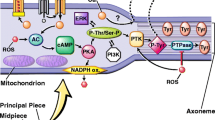Summary.
Spermatozoa were the first cell type suggested to generate reactive oxygen species. However, a lack of standardization in sperm preparation techniques and the obfuscating impact of contaminating cell types in human ejaculates have made it difficult to confirm that mammalian germ cells do, in fact, make such reactive metabolites. By identifying, on a molecular level, those entities involved in reactive oxygen species generation and demonstrating their presence in spermatozoa, the role of redox chemistry in the control of sperm function can be elucidated. Two major proteins have apparently been identified in this context, namely, NOX5, a calcium-activated NADPH oxidase, and nitric oxide synthase. Understanding the involvement of these enzymes in sperm physiology is essential if we are to understand the causes of oxidative stress in the male germ line.
Similar content being viewed by others
Author information
Authors and Affiliations
Additional information
Received May 2, 2002; accepted July 26, 2002; published online May 21, 2003
RID="*"
ID="*" Correspondence and reprints: Discipline of Biological Sciences, University of Newcastle, Callaghan, NSW 2308, Australia.
Rights and permissions
About this article
Cite this article
Baker, M., Krutskikh, A. & Aitken, R. Biochemical entities involved in reactive oxygen species generation by human spermatozoa. Protoplasma 221, 145–151 (2003). https://doi.org/10.1007/s00709-002-0057-0
Issue Date:
DOI: https://doi.org/10.1007/s00709-002-0057-0




